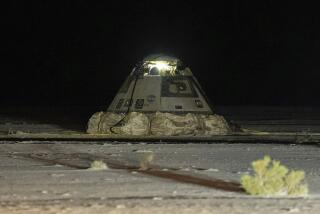Home Is the Voyager
- Share via
Faith is what sets these holidays apart from other holidays. And faith surely was flying escort when Voyager, looking frail as a spent dragonfly, glided back to the Mojave Desert nine days and 26,000 miles after it took off. Precious little else could explain how this spindly creation had beat its way around the world--not even the talents of its designer or the groggy courage of its crew.
When pilot Richard Rutan, 49, and co-pilot Jeana Yeager, 34, headed west across the Pacific, the incredible task that Voyager and its crew had let themselves in for seemed, for many of us, one more thing to worry about at a time when the world had more to worry about than it could handle. In that, we were not disappointed.
Nor were Yeager and Rutan, who told their support group by radio a few days ago that no matter how they yearned to be back on Earth, they had learned not to think about it.
“It seems like every time we thought about that or talked about that . . . we were brought very hard back to reality by a thunderstorm or some other problem that let us know that you’re a long way from completing this thing,” Rutan said.
Both wing tips, drooping under their heavy burden of fuel, were scraped off when the Voyager departed. Rutan and Yeager slept fitfully, when at all, and often breathed pure oxygen to keep from falling asleep at the controls. Turbulence bounced them against bulkheads that beat them black and blue. They wallowed through a Caribbean thunderstorm with first one wing and then the other standing straight up in the air. The whole Voyager team worried more than once that the plane would run out of fuel before it got home. One engine ran low on oil and overheated.
They conquered towering mountains and thunderstorms over Africa, a stretch that left Rutan emotionally drained and in tears as Voyager cleared land and headed across the Atlantic. With home almost in sight, one engine died and the alternate was slow to start up--an episode that Rutan reported left “teeth marks on my heart.”
When Voyager’s wheels kissed the ground in a perfect landing Tuesday, that Rutan and Yeager had survived the nine days in their slow-motion torture chamber seemed more a cause to celebrate than that they had flown around the world without stopping and without refueling.
Some people worried less about the flight than about what would posses anyone to crawl into an airplane that was held together with epoxy glue and whose wings flap, let alone try to fly it around the world. Some worried even more when a team spokesman said that Voyager’s technology would someday allow people to fill the skies with air-planes the way they fill highways with automobiles. After the landing, some may have worried that the trip would never end as the Voyager taxied this way and that, searching for a place to rest in response to conflicting instructions.
These and all other worries fell away when the propellers stopped spinning. What was left was that rare sensation of wonderment in the presence of a man and a woman who had done what no others had done--achieved by skills, by almost casual courage under duress, and by faith that it could be done.
More to Read
Sign up for The Wild
We’ll help you find the best places to hike, bike and run, as well as the perfect silent spots for meditation and yoga.
You may occasionally receive promotional content from the Los Angeles Times.






